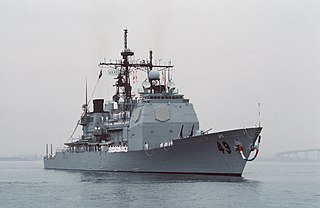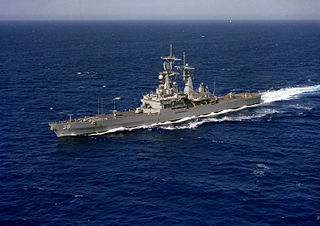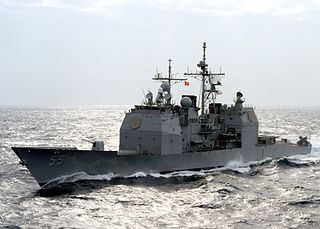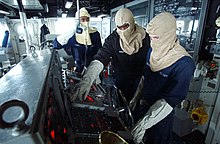
USS Dwight D. Eisenhower (CVN-69) is a nuclear-powered aircraft carrier currently in service with the United States Navy. Commissioned in 1977, the ship is the second of ten Nimitz-class aircraft carriers currently in service, and is the first ship named after the 34th President of the United States and General of the Army, Dwight D. Eisenhower. The vessel was initially named simply as USS Eisenhower, much like the lead ship of the class, Nimitz, but the name was changed to its present form on 25 May 1970. The carrier, like all others of her class, was constructed at Newport News Shipbuilding Company in Virginia, with the same design as the lead ship, although the ship has been overhauled twice to bring her up to the standards of those constructed more recently.

USS Port Royal (CG-73) was a Ticonderoga-class guided missile cruiser that served in the United States Navy. She was commissioned on 9 July 1994, as the 27th and final ship of the class. Port Royal was named in honor of the two naval battles of Port Royal Sound, South Carolina, one during the American Revolutionary War, the other during the American Civil War. She was decommissioned on 29 September 2022. The ship is the second to bear the name, with the first being a steam-powered, side-wheel gunboat, from New York City, in commission from 1862 to 1866.

USS Vincennes (CG-49) was a Ticonderoga-class guided missile cruiser outfitted with the Aegis combat system that was in service with the United States Navy from July 1985 to June 2005. She was one of 27 ships of the Ticonderoga class constructed for the United States Navy and one of five equipped with the Mark 26 Guided Missile Launching System.

USS Ticonderoga (DDG/CG-47), nicknamed "Tico", was a guided-missile cruiser built for the United States Navy. She was the lead ship of the Ticonderoga class and the first U.S. Navy combatant to incorporate the Aegis combat system. Originally ordered as a guided-missile destroyer, she was redesignated as a cruiser after capabilities from the cancelled Strike cruiser program were implemented into the ship's design. The new AEGIS system allowed Ticonderoga to track and engage many aerial targets more effectively than any previous U.S. Navy warship.

USS Bunker Hill (CG-52) was a Ticonderoga-class guided missile cruiser of the United States Navy constructed by Litton-Ingalls Shipbuilding Corporation at Pascagoula, Mississippi and launched on 11 March 1985. The Ticonderoga-class cruisers are equipped with the Aegis Combat System and Bunker Hill is the first of the class to be equipped with the Mark 41 Vertical Launching System (VLS) in place of the previous ships' twin-arm Mark 26 missile launchers, which greatly improved the flexibility and firepower of the ships by allowing them to fire BGM-109 Tomahawk cruise missiles for land attack missions. Other missions include ballistic missile defence and capital ship escort for anti-aircraft defense. The ship was commissioned on 20 September 1986 and was homeported at Naval Base San Diego in San Diego, California.

USS Cape St. George (CG-71) is a Ticonderoga-class cruiser laid down by the Litton-Ingalls Shipbuilding Corporation at Pascagoula, Mississippi, on 19 November 1990, launched on 10 January 1992, and commissioned on 12 June 1993. Cape St. George operates out of San Diego, California, and administratively reports to the Commander, Naval Surface Forces Pacific.

The Spruance-class destroyer was developed by the United States to replace the many World War II–built Allen M. Sumner- and Gearing-class destroyers, and was the primary destroyer built for the United States Navy during the 1970s and 1980s. It was named in honor of U.S. Navy Admiral Raymond A. Spruance, who successfully led major naval battles in the Asiatic-Pacific Theater during World War II such as the Battle of Midway and the Battle of the Philippine Sea.

USS Vella Gulf (CG-72) is a Ticonderoga-class guided missile cruiser that served with the United States Navy. She was the second ship named for the Battle of Vella Gulf, a naval engagement in the Solomons campaign of World War II, the first being USS Vella Gulf (CVE-111), an escort carrier commissioned in 1945. The ship's keel was laid down on 22 April 1991 at Pascagoula, Mississippi, by Ingalls Shipbuilding, then a division of Litton Industries. She was launched on 13 June 1992, sponsored by Mary A. McCauley, wife of Vice Admiral William F. McCauley (Ret.), and commissioned on 18 September 1993 at Naval Station Norfolk.

The Ticonderoga class of guided-missile cruisers is a class of warships of the United States Navy, first ordered and authorized in the 1978 fiscal year. It was originally planned as a class of destroyers. However, the increased combat capability offered by the Aegis Combat System and the passive phased array AN/SPY-1 radar, together with the capability of operating as a flagship, were used to justify the change of the classification from DDG to CG shortly before the keels were laid down for Ticonderoga and Yorktown.

The Virginia class were four nuclear-powered, guided-missile cruisers that served in the United States Navy until the mid-to-late 1990s. The double-ended cruisers were commissioned between 1976 and 1980. They were the final class of nuclear-powered cruisers completed and the last ships ordered as Destroyer Leaders under the pre-1975 classification system.

USS Mobile Bay (CG-53) was a Ticonderoga class guided-missile cruiser that served in the United States Navy from 1987 to 2023. She is named for the naval Battle of Mobile Bay during the American Civil War in 1864.

USS Leyte Gulf (CG-55) is a Ticonderoga-class guided missile cruiser in the United States Navy. She was named in memory of the World War II Battle of Leyte Gulf in the Pacific. She is powered by four large gas-turbine engines, and she has a large complement of guided missiles for air defense, attack of surface targets at sea and ashore, and anti-submarine warfare (ASW). In addition, she carries two "Seahawk" LAMPS multi-purpose helicopters, whose primary mission is ASW.

USS San Jacinto (CG-56) was a Ticonderoga-class cruiser in the United States Navy. She is named for the Battle of San Jacinto, the decisive battle of the Texas Revolution.

USS Philippine Sea (CG-58) is a Flight II Ticonderoga-class guided missile cruiser on active service in the United States Navy. She is named for the Battle of the Philippine Sea during World War II and is the second ship to bear the name. She has completed multiple deployments as part of Operation Enduring Freedom from 2001 to 2014.

USS Normandy (CG-60) is a Ticonderoga-class guided-missile cruiser in the service of the United States Navy. Armed with naval guns and anti-air, anti-surface, and anti-submarine missiles, plus other weapons, she is equipped for surface-to-air, surface-to-surface, and anti-submarine warfare. The cruiser was the first US warship since 1945 to go to war on her maiden cruise, and in 1998 was awarded the title "Most Tomahawks shot by a U.S. Navy Cruiser". She is named for the World War II Battle of Normandy, which took place in France on, and following, D-Day.

USS Lake Erie (CG-70) is a Ticonderoga-class guided missile cruiser of the United States Navy, commissioned in 1993. She was named after the U.S. Navy's decisive victory in the Battle of Lake Erie during the War of 1812. The cruiser was the first U.S. Navy ship to be commissioned in Hawaii.

USS Mason (DDG-87) is an Arleigh Burke-class guided missile destroyer in the United States Navy. She is named in honor of the Black crewmembers who served on board USS Mason (DE-529) during the period of racial segregation in the United States Armed Forces.
The names of commissioned ships of the United States Navy all start with USS, for United States Ship. Non-commissioned, primarily civilian-crewed vessels of the U.S. Navy under the Military Sealift Command have names that begin with USNS, standing for United States Naval Ship. A letter-based hull classification symbol is used to designate a vessel's type. The names of ships are selected by the Secretary of the Navy. The names are those of states, cities, towns, important persons, important locations, famous battles, fish, and ideals. Usually, different types of ships have names originated from different types of sources.

USS Rentz (FFG-46) was a United States Navy Oliver Hazard Perry-class guided missile frigate. She was named for George S. Rentz, a World War II Navy Chaplain, posthumously awarded the Navy Cross for actions following the loss of USS Houston in the Battle of Sunda Strait. He was the only Navy chaplain to be so honored during World War II.

USS California (CGN-36), the lead ship of the California-class of nuclear-powered guided missile cruisers, was the sixth warship of the United States Navy to be named for the state of California. She was the last active nuclear-powered cruiser for the United States.




















